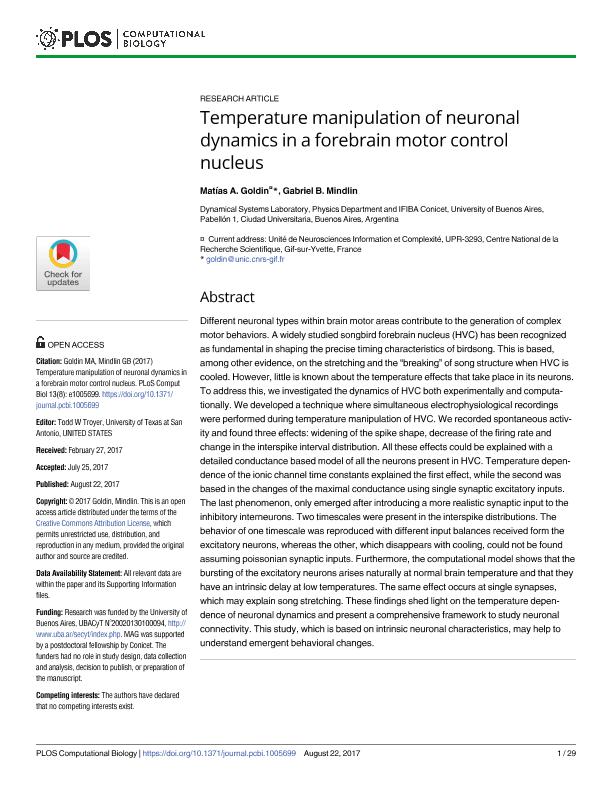Artículo
Temperature manipulation of neuronal dynamics in a forebrain motor control nucleus
Fecha de publicación:
08/2017
Editorial:
Public Library of Science
Revista:
PLoS Biology
ISSN:
1544-9173
e-ISSN:
1545-7885
Idioma:
Inglés
Tipo de recurso:
Artículo publicado
Clasificación temática:
Resumen
Different neuronal types within brain motor areas contribute to the generation of complex motor behaviors. A widely studied songbird forebrain nucleus (HVC) has been recognized as fundamental in shaping the precise timing characteristics of birdsong. This is based, among other evidence, on the stretching and the "breaking" of song structure when HVC is cooled. However, little is known about the temperature effects that take place in its neurons. To address this, we investigated the dynamics of HVC both experimentally and computationally. We developed a technique where simultaneous electrophysiological recordings were performed during temperature manipulation of HVC. We recorded spontaneous activity and found three effects: widening of the spike shape, decrease of the firing rate and change in the interspike interval distribution. All these effects could be explained with a detailed conductance based model of all the neurons present in HVC. Temperature dependence of the ionic channel time constants explained the first effect, while the second was based in the changes of the maximal conductance using single synaptic excitatory inputs. The last phenomenon, only emerged after introducing a more realistic synaptic input to the inhibitory interneurons. Two timescales were present in the interspike distributions. The behavior of one timescale was reproduced with different input balances received form the excitatory neurons, whereas the other, which disappears with cooling, could not be found assuming poissonian synaptic inputs. Furthermore, the computational model shows that the bursting of the excitatory neurons arises naturally at normal brain temperature and that they have an intrinsic delay at low temperatures. The same effect occurs at single synapses, which may explain song stretching. These findings shed light on the temperature dependence of neuronal dynamics and present a comprehensive framework to study neuronal connectivity. This study, which is based on intrinsic neuronal characteristics, may help to understand emergent behavioral changes.
Palabras clave:
Birdsong
,
Neuroscience
,
Rhythms
Archivos asociados
Licencia
Identificadores
Colecciones
Articulos(IFIBA)
Articulos de INST.DE FISICA DE BUENOS AIRES
Articulos de INST.DE FISICA DE BUENOS AIRES
Citación
Goldin, Matías Alejandro; Mindlin, Bernardo Gabriel; Temperature manipulation of neuronal dynamics in a forebrain motor control nucleus; Public Library of Science; PLoS Biology; 13; 8; 8-2017; 1-29
Compartir
Altmétricas




